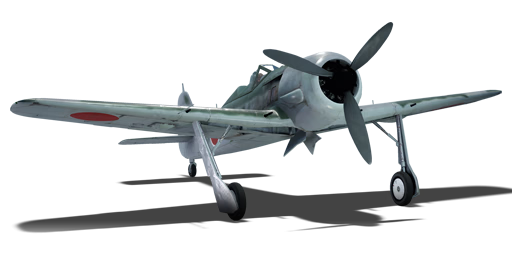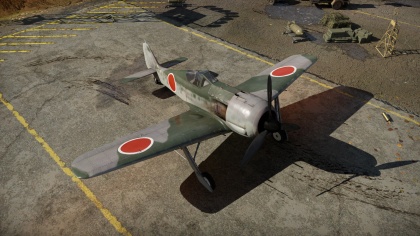Fw 190 A-5 (Japan)
Contents
| This page is about the aircraft Fw 190 A-5 (Japan). For other uses, see Fw 190 (Disambiguation) |
Description
The ▅Fw 190 A-5 is a premium Rank IV Japanese fighter
with a battle rating of 5.3 (AB) and 4.7 (RB/SB). It was in the game since the start of the Open Beta Test prior to Update 1.29 as the Fw 190 A-5/U3; it was renamed to the Fw 190 A-5 in Update 1.35. It costs 1,750 GE.
"Würger" is the German nickname of this beast of a plane. It can be translated as slayer, choker, or strangler. In that regard fits the English designation well too: "Butcher-bird"
One nineties are fighters, while this one can load additional payload, it will reduce the planes combat ability. Using it as a fighter-bomber is generally not advised, this would be the duty of the 190F-8. Whether to load the extra four 20 mm gunpods is personal preference, but like bombs they reduce the performance greatly and the plane has good armament without the extra cannons.
Rocking four 20 mm cannons, an armored radial engine, armored fuel tanks and sometimes two artillery rockets this aircraft is far but shy in the giving and taking role. Anything at 12 o'clock is soon to be dead. The wingroot mounted cannons should be additionally placed on a separate key for head-on attacks. The outer-wing guns would only miss on distances of 800-1,000 m (~0.7 miles). This also helps for tricky shots, as the second pair of 20 mm guns only has 90 shots each, instead of the whooping 250 of the inner ones. But make sure to bring hell loose ones you have the optimal firing solution.
The rockets are an interesting piece of equipment. Developed from the 210 Nebelwerfer artillery system they were originally rather used to break up B-17 formations by forcing the US pilots to evade them. This was rather done to safely get closer to now separate lone bombers then actually use the rockets to kill them. The BR.21 has the same shell drop as the Mk108 cannon, so if you are already used to it from flying 109 well done. If not, which wouldn't be a surprise as this is the page for the Fw 190, then prepare for some misses. Like the "Sledgehammer" the accuracy is woeful, not made better by the low velocity. A characteristic noticeable in-game which makes them difficult to use in direct fighter to fighter engagements. But all of these deficits are made up by the warhead. Oh boy... they've got power. With the fuze timer set correctly even misses will damage enemy planes, as the shockwave radius gets close to 100 m. So watch-out when using them against ground units. You will most likely just kill yourself, over 100 m safety distance is strongly advised!!!
General info
Flight Performance
| Characteristics | |||||||
|---|---|---|---|---|---|---|---|
| Stock | |||||||
| Max Speed (km/h at 5,800 m) |
Max altitude (meters) |
Turn time (seconds) |
Rate of climb (meters/second) |
Take-off run (meters) | |||
| ABN1K2-J | RB | AB | RB | AB | RB | ||
| ? | ? | 12000 | ??.? | ??.? | ??.? | ??.? | 420 |
| Upgraded | |||||||
| Max Speed (km/h at 5,800 m) |
Max altitude (meters) | Turn time (seconds) | Rate of climb (meters/second) |
Take-off run (meters) | |||
| AB | RB | AB | RB | AB | RB | ||
| 676 | 648 | 12000 | 20.6 | 22.0 | 22.1 | 14.1 | 420 |
Details
| Features | ||||
|---|---|---|---|---|
| Combat flap | Take-off flap | Landing flap | Air brakes | Arrestor gear |
| X | ✓ | ✓ | X | X |
| Limits | ||||
|---|---|---|---|---|
| Wing-break speed (km/h) |
Gear limit (km/h) |
Max Static G | ||
| + | - | |||
| 0 | 310 | ~19 | ~19 | |
| Optimal velocities | |||
|---|---|---|---|
| Ailerons (km/h) |
Rudder (km/h) |
Elevators (km/h) |
Radiator (km/h) |
| < 420 | < 510 | < 510 | > 280 |
| Compressor (RB/SB) | ||
|---|---|---|
| Setting 1 | ||
| Optimal altitude | 100% Engine power | WEP Engine power |
| 1,500 m | 1,604 hp | 1,822 hp |
| Setting 2 | ||
| Optimal altitude | 100% Engine power | WEP Engine power |
| 5,900 m | 1,444 hp | 1,640 hp |
Survivability and armour
- 57 mm Bulletproof glass in front of the cockpit
- 3-5 mm Steel plates in front of oil cooling system
- 6 mm Steel plate under the radial engine
- 12 mm Steel plate in pilot's headrest, and a 8 + 6 mm steel plates behind the pilot
- 8 mm Steel plate under the cockpit
- 5 mm Steel plate behind the fuel tank
Armaments
Offensive armament
Usage in the battles
The Fw 190A-5/U2, as all the planes in this line, are some of the best Boom & Zoomers in the game and should be flown exclusively in this style. The performance at high speeds is excellent, as is their dive and zoom characteristics. 'Do not ever engage in a turn fight as this will most likely end bad. Instead fight only in the vertical. Try to have an altitude, or speed advantage over your opponents (by climbing to the side at the start of the battle and then enter the highest battle you see). But you can still win fights, when you are lower in energy than your foe.
In the defensive, you can often just dive away from planes, such as Spitfires and La-5s, but you need at a decent altitude to gain top speed, so do not be to quick to dive after an enemy, if they fly below your plane. Unless you are higher then everybody else, or alone. Just be sure then to have the time to regain the lost altitude.
In a dive the 190 can, due its short wings, pull quite some stunts to either lose the hunter, or even make him lose his own wings! This is favorable strategy against La-5s, Yaks & Spitfires who have due their low wing-loading (and partly wooden wings for the Russians), less resistance against high G maneuvers. Again be sure to regain your energy by a zoom-climb. Just look out while doing so, many pilots die as they do not notice a second enemy aircraft approaching. German proverb:"Wenn Zwei sich streiten, freut sich der Dritte." ~ "When two quarrel, the third will reap the success." Of course this could also be you.
Manual Engine Control
| MEC elements | ||||||
|---|---|---|---|---|---|---|
| Mixer | Pitch | Radiator | Supercharger | Turbocharger | ||
| Oil | Water | Type | ||||
| Controllable | Not controllable | Not controllable | Not controllable | Separate | Not ontrollable | Not controllable |
Modules
| Tier | Flight performance | Survivability | Weaponry | ||
|---|---|---|---|---|---|
| I | Fuselage Repair | Radiator | Offensive 7 mm | ||
| II | Compressor | Airframe | New 7 mm MGs | ||
| III | Wings Repair | Engine | Offensive 20 mm | Offensive 20 mm | |
| IV | Engine Injection | Cover | New 20 mm Cannons | New 20 mm Cannons | |
Pros and cons
Pros:
- Best roll rate
- Good climb rate
- Performs very well in dives
- Good at Boom & Zoom
- Excellent firepower
Cons:
- Engine overheats fast
- Not that fast in level flight
- Turns poorly
- Not much defensive possibilities (only dive and scissors)
History
In 1943, the Imperial Japanese Navy Air Service imported one Fw 190 A-5 from Germany,[1] which was delivered via submarine. The Fw 190 A-5 model was tested at the Fussa airfield, the Imperial Japanese Army's central testing facility for aircraft. The plane was flown by Lieutenant Commander Aramaki Yoshitsugu, who found the Fw 190 cockpit size just right as opposed to the tightness of the Bf 109 or the spaciousness of a P-40.[2]
The Fw 190 A-5 was also tested alongside Japanese aircraft and prototypes, including the prototypes that would be the Ki-84 and Ki-100. During these, it was deemed that the Fw 190 performance was similar to that of the Ki-84. Overall Japanese impression of the Fw 190 A-5 was positive, with better firepower than most other Japanese planes, reliable electric systems, fine craftsmanship, and a reliable engine.[2]
The Allied code names for Japanese planes predicted that the Japanese would use the Fw 190 as a fighter aircraft and gave the Fw 190 the nickname "Fred" in 1942.[1][3] However, it is not known if the Japanese ever used the Fw 190 in combat purposes against the Allies. The last known reported presence of the Fw 190 A-5 was it being loaned to a reconnaissance unit, with its ultimate fate unknown but presumably lost.[2]
Media
An excellent addition to the article will be video guides, as well as screenshots from the game and photos.
Read also
Links to the articles on the War Thunder Wiki that you think will be useful for the reader, for example,
- reference to the series of the aircraft;
- links to approximate analogues of other nations and research trees.
Sources
- Arawasi. "Japanese Focke-Wulf Fw 190." WildEagles. N.p., 22 Jan. 2014. Web. 01 Feb. 2018. Website.
- Dyer, Edwin M. Japanese Secret Projects: Experimental Aircraft of the IJA and IJN, 1939-1945. Midland, 2009.
- Hanson, David. "Focke-Wulf Fw 190A5 (Fred)." Dave's Warbirds. N.p., n.d. Web. 01 Feb. 2018. Website.
| Japan fighters | |
|---|---|
| Navy | |
| Carrier-based fighter | |
| A5M | A5M4 · Hagiri's A5M4 |
| A6M | A6M2 mod. 11 · A6M2 · A6M3 · A6M3 mod. 22 · A6M3 mod. 22Ko · A6M5 · A6M5 Ko · A6M5 otsu · A6M5 Hei · A6M6c |
| A7He | A7He1* |
| A7M | A7M1 (NK9H) · A7M2 |
| Land-based Fighter | |
| J2M | J2M2 · J2M3 · J2M4 Kai · J2M5 · J2M5 (30 mm) |
| J6K | J6K1 |
| J7W | J7W1 |
| N1K-J | N1K1-Ja · N1K2-J · N1K2-Ja |
| Fighter seaplane | |
| N1K | N1K1 |
| A6M-N | A6M2-N |
| Army | |
| Ki-10 | Ki-10-I · Ki-10-I C · Ki-10-II · Ki-10-II C |
| Ki-27 | Ki-27 otsu · Ki-27 otsu Tachiarai |
| Ki-43 | Ki-43-I · Ki-43-II · Ki-43-III otsu |
| Ki-44 | Ki-44-I · Ki-44-I 34 · Ki-44-II otsu · Ki-44-II hei |
| Ki-61 | Ki-61-I ko · Ki-61-I otsu · Ki-61-I hei · Tada's Ki-61-I hei · Ki-61-I tei · Ki-61-II Otsu Kai |
| Ki-84 | Ki-84 ko · Ki-84 otsu · Ki-84 hei |
| Ki-87 | Ki-87 |
| Ki-94 | Ki-94-II |
| Ki-100 | Ki-100 · Ki-100-II |
| Other countries | ▅F4U-1A · ▅P-51C-11-NT · ▅Bf 109 E-7 · ▅Fw 190 A-5 |
| *Imported designation of the He 112 (A6M was in development - A7M would take A7 designation after the cancelation of the A7He) | |





